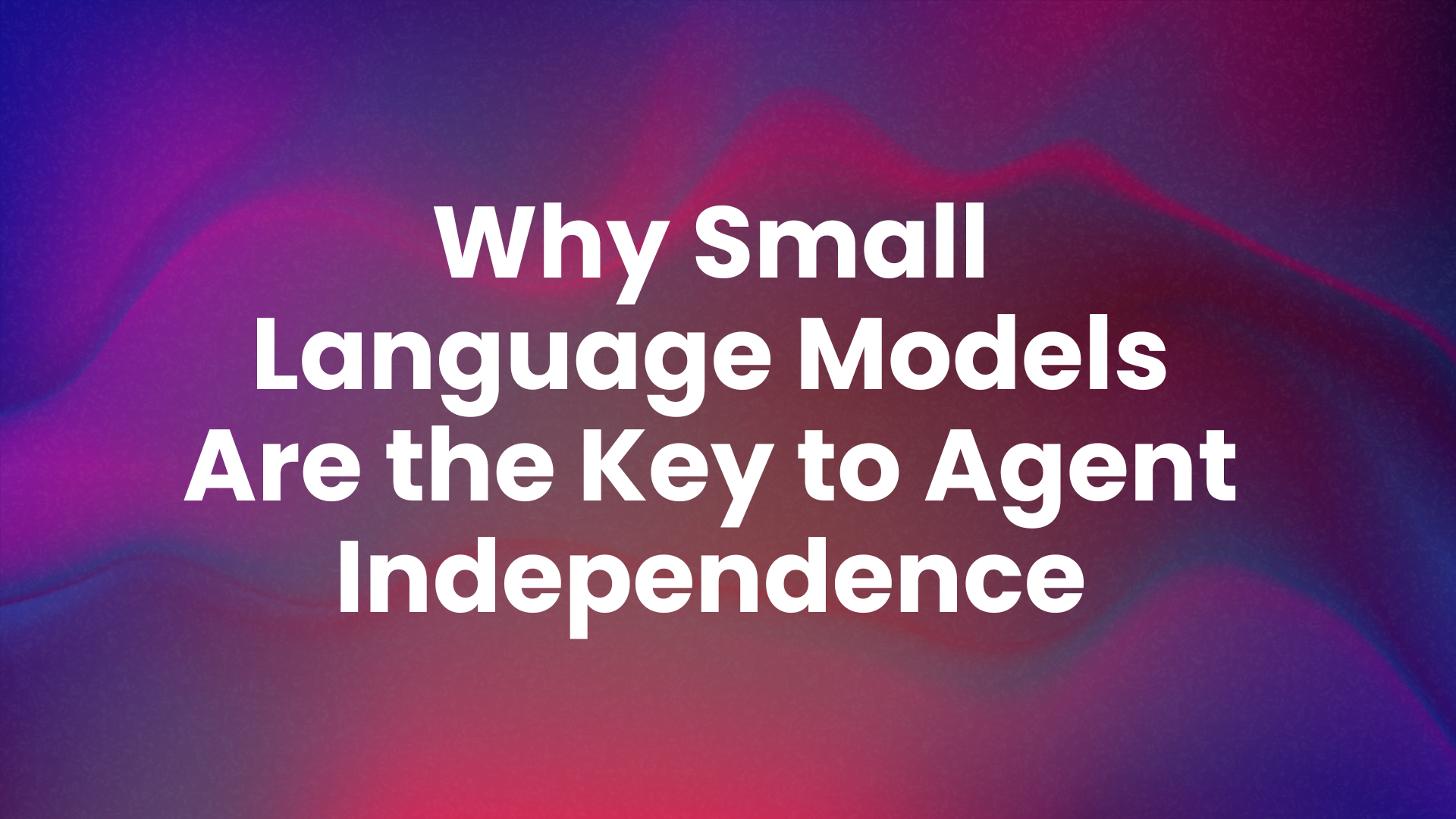Why Small Language Models Are the Key to Agent Independence
As enterprises embed AI into their operating models, a dependency is forming that carries significant strategic risk. Across financial services, manufacturing, energy and beyond, organisations are standardising on a narrow set of foundation models: primarily OpenAI's GPT family, Anthropic's Claude and Google's Gemini. Whilst these Large Language Models (LLMs) have undeniable valuable, this concentration creates vulnerabilities that technology leaders must address.
We are at an inflexion point. The question is no longer whether AI will be embedded into business processes, but whether organisations will retain control over the intelligence that powers them. This week alone saw major announcements from Google, OpenAI and Amazon Web Services around all things agents, LLM interactions and enterprise solutions. Yet, with sovereign AI becoming and increasingly critical consideration on an international stage, might AI dependence also be a key consideration for enterprise organisations moving forward. After all, if you are a Tier 1 bank and you are using the same model as another competitor, what is your key differentiation?
Let’s explore this in more detail.
The Concentration Risk Challenge
The reality of enterprise AI adoption today is stark. Three model families dominate the landscape, and once integrated into workflows, customer touchpoints and decision making processes, these dependencies become difficult to unpick. The reasons are clear:
Lock-in by Design: LLMs become entwined with proprietary data pipelines, fine tuning investments and business logic. Removing a model provider isn't just technically complex, it requires re-engineering entire product experiences and retraining teams.
Vendor Control Over Evolution: When an LLM provider deprecates a model, adjusts pricing or changes API behaviour, enterprises must adapt on the vendor's timeline, not their own. Upgrade paths, fallback strategies and model versioning sit firmly in the hands of external parties.
Opaque Training and Explainability Gaps: For regulated industries (financial services, healthcare, insurance), the inability to explain precisely what data shaped a model's behaviour poses real compliance and governance challenges. Closed-box LLMs leave audit trails incomplete.
These aren't hypothetical concerns. They're operational realities that CIOs, CTOs and risk committees are confronting as AI moves from pilot to production at scale. So what alternatives exist?
Enter Small Language Models: Purpose Built Intelligence for Agentic Systems
Small Language Models (SLMs) represent a strategic counterpoint to this concentration risk. Unlike their larger contemporaries, SLMs are trained on specific knowledge domains and tasks, designed not for general purpose conversation but for delivering targeted outcomes within constrained contexts.
This distinction matters when considering AI agents.
Agents demand precision, not breadth: An AI agent orchestrating financial reconciliation, managing supply chain logistics or triaging customer service queries doesn't need to write poetry or debate philosophy. It needs to execute specific, repeatable tasks with reliability and accuracy. SLMs excel here, their focused training means fewer hallucinations, tighter reasoning boundaries and more predictable behaviour.
Agents operate within systems, not isolation: Modern agentic architectures (whether leveraging frameworks like Model Context Protocol (MCP) or bespoke orchestration layers) require models that integrate with enterprise data, tooling and governance. SLMs, by virtue of their size and specificity, slot into these systems with lower latency, reduced token costs and greater flexibility.
Agents scale through specialisation: Rather than routing every task through a single, monolithic LLM, organisations can deploy multiple SLMs, each fine tuned for distinct functions. One SLM might handle contract analysis, another customer intent classification, a third product recommendations. This modular approach mirrors the distributed intelligence enterprises already rely upon in human teams.
The Open Source Advantage: Owning Your Intelligence
The strategic value of SLMs emerges when combined with open source foundations. Open source SLMs (built on models like Llama, Mistral or Phi) afford organisations something LLMs from proprietary vendors cannot: ownership.
1. Control Over Upgrade and Fallback Paths
When you own the model, you dictate the timeline for upgrades. If a new version introduces undesirable behaviour or breaks existing integrations, you retain the ability to revert, adjust or selectively adopt changes. You're no longer at the mercy of vendor deprecation schedules or forced migrations.
Open source SLMs also enable organisations to maintain multiple model versions in parallel, running agents on stable, proven releases whilst experimenting with newer iterations in controlled environments. This flexibility is essential for mission critical operations where downtime or unpredictability is unacceptable.
2. Transparency and Explainability for Regulated Environments
For heavily regulated industries, explainability isn't just a nice to have, it's a legal and operational imperative. Open source SLMs allow organisations to audit training data, understand model biases and trace decision logic in ways proprietary LLMs simply cannot support.
This transparency extends to data governance. Organisations can dictate precisely what data is used for fine tuning and retraining, ensuring compliance with GDPR, CCPA and sector specific regulations like MiFID II or Solvency II. You control the provenance of intelligence, not a third party.
3. Cost Predictability and Infrastructure Sovereignty
Running open source SLMs on premises or within cloud environments eliminates the variable cost structures of API based LLMs. For high frequency agent operations (processing thousands of interactions per hour), predictable infrastructure costs matter. You're no longer subject to token pricing fluctuations or usage caps that can throttle performance during peak demand.
Training costs for SLMs are significantly lower than their larger counterparts. Where frontier LLMs have historically required budgets in the tens or hundreds of millions, SLMs can be trained and fine tuned for a fraction of that investment. This economic advantage makes it feasible for organisations to maintain multiple specialised models rather than relying on a single, general purpose foundation.
However, this proliferation of models introduces new governance challenges. Managing dozens or hundreds of SLMs across an enterprise requires rigorous data governance, comprehensive traceability and robust audit trails. For regulated businesses, this means documenting precisely what data was used to train each model, maintaining version control across model iterations and establishing clear lineage from training data to production deployment. The independence that SLMs afford comes with a responsibility to govern them properly. Indeed, this investment doesn’t come cheaply.
Sovereignty matters too. Sensitive customer data, proprietary business logic and competitive intelligence remain within your perimeter. No external API calls. No data leaving your jurisdiction. No reliance on third party uptime SLAs for business critical workflows.
Practical Implementation: Building Agentic Systems with SLMs
Adopting open source SLMs for agentic systems isn't without complexity, but the strategic payoff justifies the investment. From our practical experience, several principles guide successful implementation:
Modular Agent Architecture: Design agents as composable units, each powered by SLMs optimised for their domain. Use orchestration layers (whether MCP, LangGraph, Autogen or bespoke frameworks) to coordinate agent interactions, manage context and enforce governance policies.
Rigorous Fine Tuning and Evaluation: Open source SLMs benefit from domain specific fine tuning. Invest in curated datasets, robust evaluation benchmarks and iterative refinement. The goal isn't to match LLM breadth, but to exceed LLM precision within your operating context.
Hybrid Models Where Appropriate: Not every task requires an SLM. For exploratory, human facing interactions (brainstorming, strategy formulation), LLMs remain valuable. Reserve SLMs for deterministic, repeatable agent tasks where precision, cost and control matter most.
Continuous Monitoring and Drift Detection: Just as with LLMs, SLMs require operational vigilance. Monitor agent performance, track accuracy over time and watch for distribution drift as business conditions evolve. Open source foundations make this easier, full access to model internals means deeper observability.
The Strategic Imperative
The next wave of enterprise AI won't be defined by who adopts first, but by who retains strategic control. As organisations embed AI agents into workflows, customer experiences and decision making processes, the choice of model architecture becomes a question of resilience, sovereignty and competitive differentiation.
The economics of AI are shifting too. Earlier this year, DeepSeek demonstrated that capable LLMs can be trained for significantly less than the multi-million Dollar budgets that characterised early frontier models. This development suggests that the cost barrier to building proprietary foundation models is falling, making a hybrid approach increasingly viable.
The future likely lies not in choosing between SLMs and LLMs, but in orchestrating both strategically. Open source LLMs can serve as the foundation for exploratory, reasoning intensive tasks, whilst specialised SLMs handle the deterministic, high frequency agent operations that underpin business processes. This hybrid architecture, built entirely on open source foundations, allows organisations to protect intellectual property, maintain independence from external providers and evolve their AI capabilities on their own terms.
Open source Small Language Models offer a path forward, one that balances capability with operational independence. They are purpose built for agentic systems, transparent enough for regulated environments and flexible enough to evolve on your terms.
The three model oligopoly isn't inevitable. Organisations willing to invest in open source SLMs today are positioning themselves to lead tomorrow, unburdened by vendor lock-in, empowered by explainability and equipped to scale AI on their own terms.
If your organisation is ready to explore how open source SLMs can de-risk your AI strategy whilst accelerating agentic capabilities, connect with us at hello@webuild-ai.com. Let's architect intelligence that you own, control and evolve together.
Thanks for reading!


